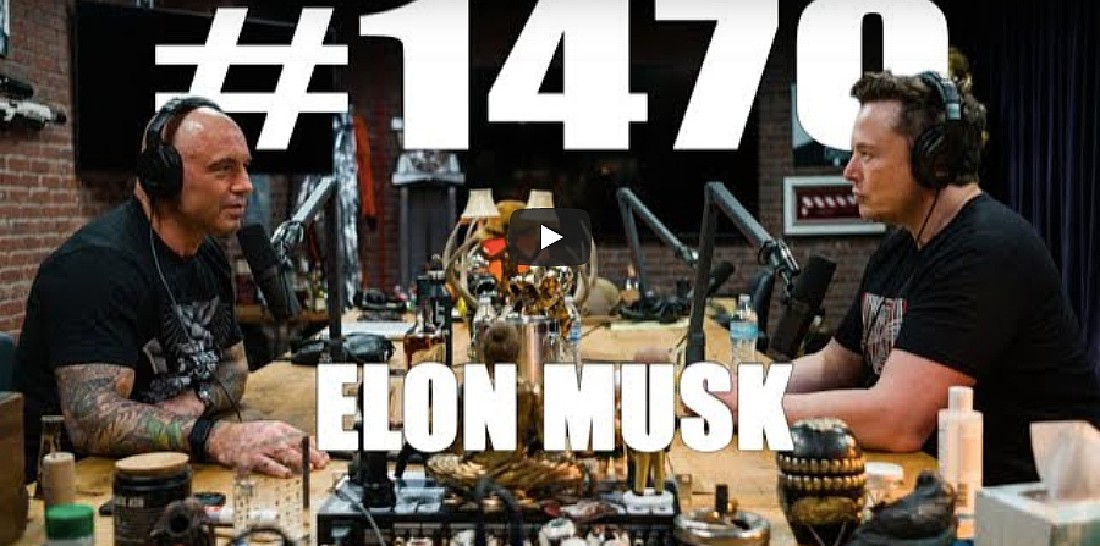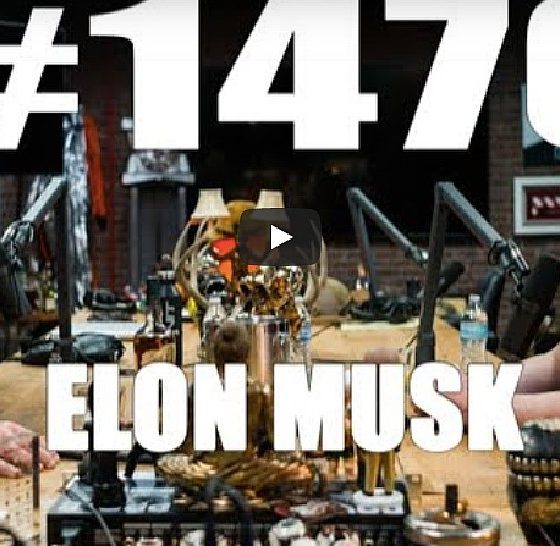

Lifestyle
Elon Musk talks Neuralink, coronavirus, and the future in Joe Rogan podcast Round 2
Tesla and SpaceX CEO Elon Musk recently made his second appearance on the widely popular Joe Rogan Experience podcast, which was released today. Unlike many of Rogan’s podcasts that are streamed live for viewers to watch in real-time, Musk’s second episode was pre-recorded and released on May 7.
Musk and Rogan, who is a commentator for the Ultimate Fighting Championship and a comedian, discussed several topics that have been in the news recently. The two shared their thoughts on Musk’s plans to sell his estate and possessions, as well as his plans for Neuralink and Mars. Rogan and Musk also discussed the coronavirus, which has been a talking point of the CEO for some time.
Plans for houses, real estate, and Mars
Last week, Musk announced on Twitter that he would be selling his houses and almost all of his physical possessions. “Devoting myself to Mars and Earth. Possession just weigh you down,” he said when a follower asked about his reasons.
Don’t need the cash. Devoting myself to Mars and Earth. Possession just weigh you down.
— Elon Musk (@elonmusk) May 1, 2020
Musk provided an interesting explanation about his decision to sell his possessions to Rogan. “People say, ‘Hey, billionaire, you’ve got all this stuff’ Well, now I don’t have stuff. Now, what are you going to do?” Musk also stated that possessions were a roadblock in personal development. Thus, instead of focusing too much on houses on Earth, the CEO stated that he’d rather dedicate his efforts to Mars.
Musk further noted that he did not see the merit in owning so many properties. After Rogan and Musk talked about Gene Wilder’s house, which is located across the street from his live-in estate, he stated that owning many homes is not practical. Also, he did not want to get caught up in the small details that come with owning a property, like interior design and features. “Does it really make sense for me to spend time designing and building a house, and I’d be getting OCD on the little details…or should I be allocating that time to getting us to Mars. I should probably do the latter,” Musk said.
Neuralink
Neuralink could come as soon as next year, Musk detailed during the podcast. The CEO outlined the process for how a brain chip will be installed, and how it would be implanted in the skull of a patient. According to Musk, a portion of the skull would be removed and replaced by a Neuralink device.
Musk believes that Neuralink could help people with brain-related health issues. It could restore limb functions, eyesight, hearing, help with neurological diseases like Parkinson’s, and improve human movement. Musk also believes that there are potential cognitive benefits to Neuralink, as it could pave the way for hindering brain issues like epilepsy, Alzheimers, and strokes. He thinks the Neuralink device could recognize these issues before the body has time to react and send a “counter pulse” that could stop the problem from occurring in the first place.
The developments of Neuralink could revolutionize human life as we know it. Development is still ongoing, and Musk believes hat a year from now, Neuralink will be available for use.
Thoughts on Coronavirus
Musk has been vocal for his discontent on COVID-19 and how it is currently being handled. Last week during Tesla’s Q1 2020 Earnings Call and then on Twitter two days later, Musk vocalized his request to lift Stay-at-Home orders, stating they were inhibiting the freedom of Americans.
“I think the mortality rate is much less than what the World Health Organization said it was,” Musk said.
He maintained this point of view during the Joe Rogan Experience Podcast, stating that more freedom should be given to citizens. Those who do not want to stay home should not be required to, and those who want to stay home should have the right to do so. Musk did maintain that he is supportive of the use of face masks when people are out in public because it could stop the transmission of any germs, illness, or virus. “I think that would be a great adoption throughout the world,” he said.
Musk’s second meeting with Joe Rogan also included a brief update to Tesla’s plans with the Cybertruck and Roadster, where he indicated the all-electric pickup should come before the supercar.
The constructive conversation between the two influential figures helped clear the air with some of the more controversial topics surrounding Musk today. A year and a half removed from their first meeting, Musk and Rogan’s relationship seems to be relaxed and constructive as the two men maintained plenty of interesting conversational pieces for viewers to feast on.
Watch Episode 1470 of the Joe Rogan Experience, featuring Elon Musk below.

Lifestyle
Tesla Model S Plaid battles China’s 1500 hp monster Nurburgring monster, with surprising results
There is just something about Tesla’s tuning and refinement that makes raw specs seem not as game-changing.

The Tesla Model S Plaid has been around for some time. Today, it is no longer the world’s quickest four-door electric sedan, nor is it the most powerful. As per a recent video from motoring YouTube channel Carwow, however, it seems like the Model S Plaid is still more than a match for some of its newer and more powerful rivals.
The monster from China
The Xiaomi SU7 Ultra is nothing short of a monster. Just like the Model S Plaid, it features three motors. It also has 1,548 hp and 1,770 Nm of torque. It’s All Wheel Drive and weighs a hefty 2,360 kg. The vehicle, which costs just about the equivalent of £55,000, has been recorded setting an insane 7:04.957 at the Nurburgring, surpassing the previous record held by the Porsche Taycan Turbo GT.
For all intents and purposes, the Model S Plaid looked outgunned in Carwow’s test. The Model S Plaid is no slouch with its three motors that produce 1,020 hp and 1,420 Nm of torque. It’s also a bit lighter at 2,190 kg despite its larger size. However, as the Carwow host pointed out, the Model S Plaid holds a 7:25.231 record in the Nurburgring. Compared to the Xiaomi SU7 Ultra’s record, the Model S Plaid’s lap time is notably slower.
Real-world tests
As could be seen in Carwow’s drag races, however, Tesla’s tech wizardry with the Model S Plaid is still hard to beat. The two vehicles competed in nine races, and the older Model S Plaid actually beat its newer, more powerful counterpart from China several times. At one point in the race, the Xiaomi SU7 Ultra hit its power limit due to its battery’s temperature, but the Model S Plaid was still going strong.
The Model S Plaid was first teased five years ago, in September 2020 during Tesla’s Battery Day. Since then, cars like the Lucid Air Sapphire and the Xiaomi SU7 Ultra have been released, surpassing its specs. But just like the Model Y ended up being the better all-rounder compared to the BYD Sealion 7 and the MG IM6, there is just something about Tesla’s tuning and refinement that makes raw specs seem not as game-changing.
Check out Carwow’s Model S Plaid vs Xiaomi SU7 drag race video below.
Lifestyle
500-mile test proves why Tesla Model Y still humiliates rivals in Europe
On paper, the BYD Sealion 7 and MG IM6 promised standout capabilities against the Model Y.

BYD is seeing a lot of momentum in Europe, so much so that mainstream media has taken every opportunity to argue that the Chinese automaker has beaten Tesla in the region. But while BYD sales this year in Europe are rising and Tesla’s registrations remain challenged, the raw capabilities of vehicles like the Model Y are difficult to deny.
This was highlighted in a 500-mile challenge by What Car? magazine, which showed that the new Tesla Model Y is more efficient, cheaper to run, and more reliable than rivals like the BYD Sealion 7, and even the nearly 400 KW-charging MG IM6.
Range and charging promises
On paper, the BYD Sealion 7 and MG IM6 promised standout capabilities against the Model Y. The Sealion 7 had more estimated range and the IM6 promised significantly faster charging. When faced with real-world conditions, however, it was still the Model Y that proved superior.
During the 500-mile test, the BYD nearly failed to reach a charging stop, arriving with less range than its display projected, as noted in a CarUp report. MG fared better, but its charging speeds never reached its promised nearly-400 kW charging speed. Tesla’s Model Y, by comparison, managed energy calculations precisely and arrived at each stop without issue.
Tesla leads in areas that matter
Charging times from 25% to 80% showed that the MG was the fastest at 17 minutes, while Tesla and BYD were close at 28 and 29 minutes, respectively. Overall efficiency and cost told a different story, however. The Model Y consumed 19.4 kWh per 100 km, compared to 22.2 for MG and 23.9 for BYD. Over the full trip, Tesla’s charging costs totaled just £82 thanks to its supercharger network, far below BYD’s £130 and MG’s £119.
What Car? Magazine’s testers concluded that despite BYD’s rapid sales growth and the MG IM6’s seriously impressive charging speeds, Tesla remains the more compelling real-world choice. The Model Y just offers stability, efficiency, and a proven charging infrastructure through its Supercharging network. And as per the magazine’s hosts, the Model Y is even the cheapest car to own among the three that were tested.
Watch What Car? Magazine’s 500-mile test in the video below.
Lifestyle
Tesla Cybertruck slapped with world’s least intimidating ticket, and it’s pure cringe
One cannot help but cringe and feel second-hand embarrassment at the idea of a person just driving around with a stack of these babies.

A Cybertruck parked at Stanford Shopping Center in California was recently hit with what might be the most try-hard piece of paper ever slipped under a wiper blade: a “fake citation” accusing the driver of supporting a “fascist car.”
The note, shared on X by Tesla staff program manager Ryan Torres, quickly made the rounds on X, where it quickly gained attention as an example of how not to protest.
The world’s least intimidating ticket
According to the citation, the supposed “violation” was “driving a fascist car.” The remedial action? Take the bus, call an Uber, or ride a bike. The note also dubbed Elon Musk a “chainsaw-wielding Nazi billionaire.” Now, protests against Tesla and Elon Musk have become commonplace this year, but one cannot help but cringe and feel second-hand embarrassment at the idea of a person just driving around with a stack of fake anti-Tesla/Musk citations.
Torres pointed out the irony himself in his post on X. Tesla currently employs over 140,000 Americans, and SpaceX has put the U.S. firmly back at the top of space technology. As Torres put it, maybe the person behind the world’s least intimidating ticket should “read a book on innovation before vandalizing” other people’s property.
Peak performative clownery
Not to mention that the fake ticket’s logic collapses under its own weight. EVs like the Cybertruck are literally designed to reduce emissions, not “destroy the economy.” If anything, Tesla has bolstered the United States’ economy by fueling jobs in engineering, manufacturing, and clean energy. It’s not the first time a Tesla has been the target of vandalism or politically charged notes, but this one stands out for sheer cringe value.
Torres summed it up neatly: “Peak clownery.” On that point, at least, the citation earns full marks. In a way, though, perhaps cringe fake tickets are not as bad as the literal firebombs that were being thrown at Tesla stores and cars earlier this year because some critics were gleefully misinformed about Elon Musk.








